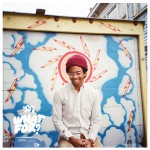Chazwick Bundick’s music has never belonged to one genre and has always been difficult to describe. Under his moniker, Toro Y Moi, he is commonly associated with the chillwave movement. However, the South Carolina native and Berkeley-based artist surprises with a heavy ’70s and ’80s influence in his newest album, “What For?”
The buzz and vroom of racecars boom in the first song off Bundick’s fourth album as Toro Y Moi. The song, “What You Want” quickly drops the sound effect and leads into a more mellow, harmonious rock feel with lyrics about pondering life to match.
“So I’ll follow you, or you follow me/ Does anyone know where we go from here?,” Bundick directs toward the listener to the lazy yet distinctive beat.
Bundick momentarily transitions away from whispery cooing in a single titled “Buffalo.” The deep, almost lo-fi, groovy lead-in picks up quickly with an infectious, funky vibe, similar to “New Beat” in his sophomore album “Underneath the Pine.” However, Bundick’s croons of disjointed lyrics come off distracting, while the accompanying drums and repetitive echoes leading up to the synth-like coda seem to compensate.
“The Flight” embodies a depressing tone from the guitar succession, but includes a more conventional, indie-rock feel. At one point, the simultaneous piano chords and guitar riffs are Queen-esque with a modern psychedelic twist. The lyrics have potential to add to the heart-wrenching sentiment, but instead struggle to grasp any real substance and are poetically ambiguous.
“You said nothing’s worse than leaving a dream/ No one gets me more than you/ What is it you want to do?,” Bundick sings.
“Empty Nesters” employs nostalgia with familiar notes and lyrics of high school dreams. Of the 10 songs, this tune includes the most pop influence, like “Cake” from Bundick’s previous album, “Anything in Return.” The song is less risky of a composition, but lends itself to the listener’s imagination. The song easily evokes the listener to envision a summer day drive or even an ethereal slide down a rainbow from which to land off of and boogie. But the excessive festive mood does not last for long.
From here, “What For?” continues with “Ratcliff,” a result of a sort of Beatles influence. This is particularly noticeable because of Bundick’s higher notes, soft and simple melodious keyboard, and guitar paired with his artificially-produced, rounded sounds. Resonating rumbles that crescendo carry the next songs, “Lilly” and “Spell It Out,” both of which return to the more lively rhythms of disco, which appears to be focus of the album.
“Half Dome” stirs hip-swaying, but nothing more. It falls short when compared to other songs on the album, and the repetitive lyrics do not wield any inherently deeper meaning. These words do not evoke passion or really any emotion, as they are delivered the most apathetically of all the songs.
“You must be waiting,” Bundick sings, ironically, for the listener who is probably patiently waiting for the song to break static, take its full form and present something unexpected, which it fails to do.
Toward the end of the concise, 10-song melting pot of sounds are “Run Baby Run” and “Yeah Right,” which add to the carefree attitude and warm atmosphere given off by the organized chaos of the album.
“What For?” is easygoing, enjoyable and plays with the dichotomy of the masked, sad undertone and cheerful ’70s style tempos sprinkled throughout. But it is not on par with Bundick’s two previous albums as Toro Y Moi, “Anything in Return” and “Underneath the Pine.” Although Bundick is known to sample and mesh different areas of music and cannot be expected to produce in the same style for each album, consistency within “What For?” would have enhanced the listening experience. It does not pack the same punch of versatility and lacks lyrically, but still integrates his signature, complexly layered sound and reveals more of his vocals.
